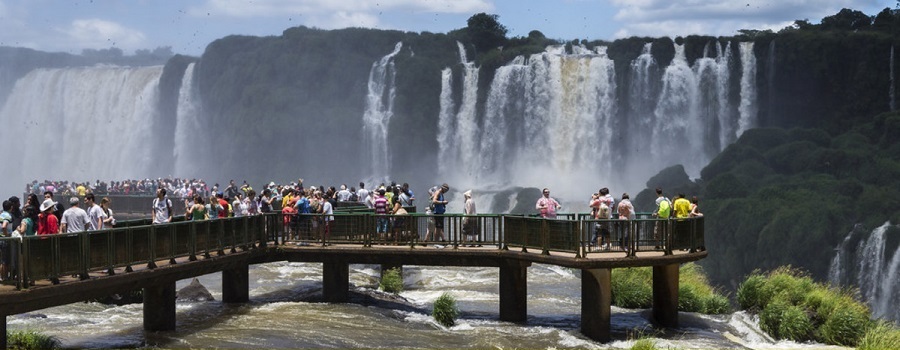(Iguazu Falls Travel Tips) – Visiting Iguazu Falls is a truly remarkable experience, as these falls are one of the most impressive natural wonders in the world. Located on the border of Argentina and Brazil, the falls offer breathtaking views, lush landscapes, and a range of activities to enjoy. Here’s a list of things to do and see when visiting Iguazu Falls.
Iguazu Falls: What to see
- Iguazu Falls National Park (Argentina)
- Iguazu Falls National Park (Brazil)
- Saltos del Monday (Paraguay)
- Ciudad del Este (Paraguay)
- Bird Park (Brazil)
- Itaipu Dam (Brazil/Paraguay)
- San Ignacio Mini (Argentina)
- Three Borders Landmark (Brazil)
- Three Borders Milestone (Argentina)
Iguazu Falls, how can we help?
Iguazu Falls National Park (Argentina)
Iguazu Falls National Park is a stunning natural wonder located in Argentina. It’s renowned for its breathtaking waterfalls, which are among the largest and most spectacular in the world. The park is situated in the northeastern province of Misiones, bordering Brazil, and encompasses a vast area of diverse ecosystems, including lush rainforests and unique flora and fauna.
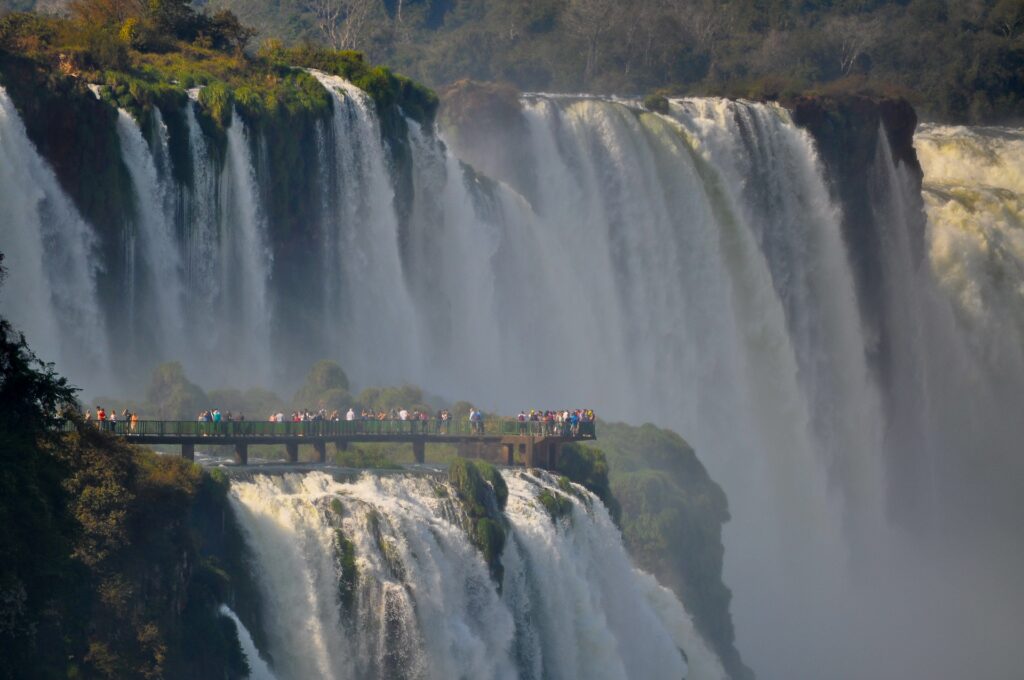
Key features of National Park: Iguazu Falls, What to see
- Iguazu Falls: The park’s main attraction, the Iguazu Falls, consists of a series of more than 270 waterfalls that span nearly 2 miles (3.2 kilometers) in width. The most famous and powerful of these falls is called “Garganta del Diablo” (Devil’s Throat). The sight and sound of the water thundering down into the deep gorge are awe-inspiring.
- Biodiversity: The national park is a UNESCO World Heritage site due to its rich biodiversity. It’s home to a wide range of plant and animal species, including various tropical birds, butterflies, and mammals. The surrounding rainforest is an integral part of the park’s ecological importance.
- Trails and Walkways: The park offers well-maintained trails and walkways that allow visitors to explore the falls and the surrounding natural beauty. These paths provide different perspectives and viewpoints, allowing visitors to appreciate the falls from various angles.
- Boat Tours: Thrilling boat tours are available, providing an up-close experience with the falls. The boat tours take you close enough to feel the mist and the power of the falls, providing a truly immersive adventure.
- Wildlife Viewing: In addition to the falls, the park is an excellent destination for wildlife enthusiasts. You may have the chance to spot coatis, monkeys, and various bird species as you explore the park.
- Accessibility: The park is easily accessible from the nearby town of Puerto Iguazu, where visitors can find accommodations, restaurants, and other amenities.
When visiting Iguazu Falls National Park, it’s essential to respect the natural environment and follow park rules to help preserve this incredible destination for future generations.
Iguazu Falls National Park (Brazil)
Known as Parque Nacional do Iguaçu in Portuguese, is a UNESCO World Heritage site located in Brazil. It shares its borders with the Iguazu Falls National Park in Argentina, and together, they form one of the most impressive and famous waterfall systems in the world. The Brazilian side of the park provides a unique perspective on the magnificent Iguazu Falls.
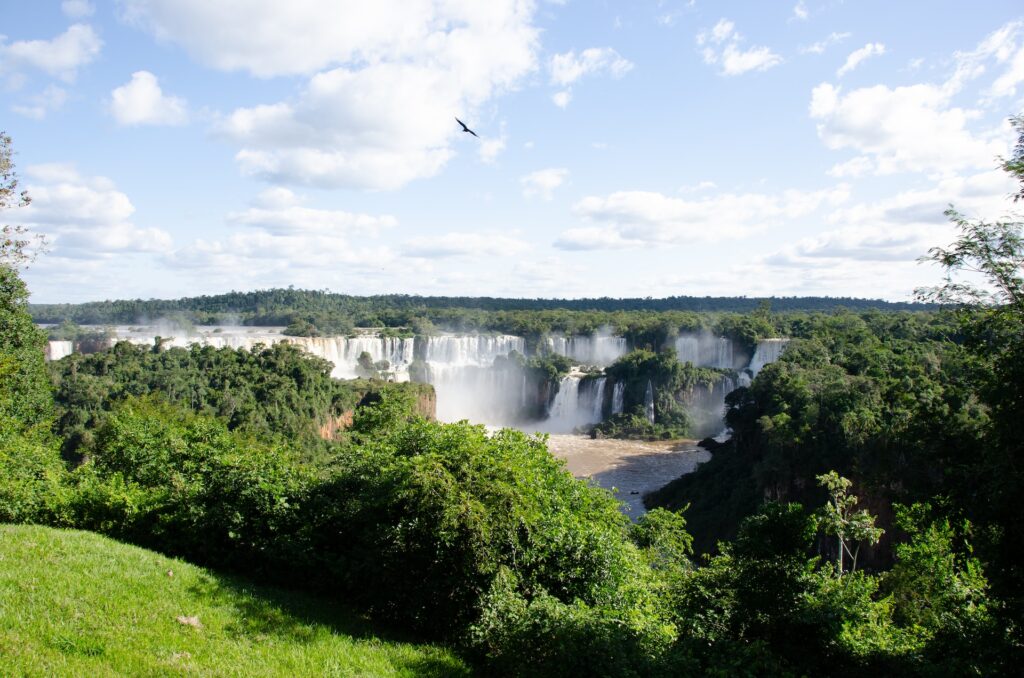
Key features of Iguazu Falls National Park on the Brazilian side:
- Panoramic Views: The Brazilian side offers some of the most iconic panoramic views of the falls, allowing visitors to witness the grandeur and sheer power of the cascades. The viewpoint from the Brazilian side provides a sweeping vista of many of the falls, including the spectacular “Garganta do Diabo” (Devil’s Throat).
- Easy Access: The Brazilian side of the park is known for its well-maintained walkways and platforms, providing easy access to the best viewpoints. It’s an excellent option for visitors who want to enjoy breathtaking views without extensive hiking.
- Bird’s-eye View: Some viewing platforms on the Brazilian side allow you to get very close to the falls, providing a bird’s-eye view of the cascades and the surrounding lush greenery. It’s an excellent opportunity for photography and taking in the natural beauty.
- Flora and Fauna: Like the Argentine side, the Brazilian park is part of a rich ecosystem that is home to various wildlife, including birds, butterflies, and other tropical species. While the focus is often on the falls, the park’s natural diversity is worth appreciating.
- Cultural Experience: The park offers cultural exhibits and educational information about the local indigenous communities, helping visitors understand the significance of the region to these cultures.
To fully appreciate the Iguazu Falls, it’s a great idea to visit both the Brazilian and Argentine sides, as each offers a distinct experience and stunning perspectives on this natural wonder. Remember to follow the park’s guidelines to ensure the conservation of this magnificent site for future generations.
Saltos del Monday (Paraguay)
“Saltos del Monday” is a prominent natural attraction in Paraguay, known for its beautiful waterfalls and lush surroundings. It’s located near Ciudad del Este, which is in the eastern part of Paraguay, close to the border with Brazil and Argentina. The name “Saltos del Monday” refers to the waterfalls in the Monday River.
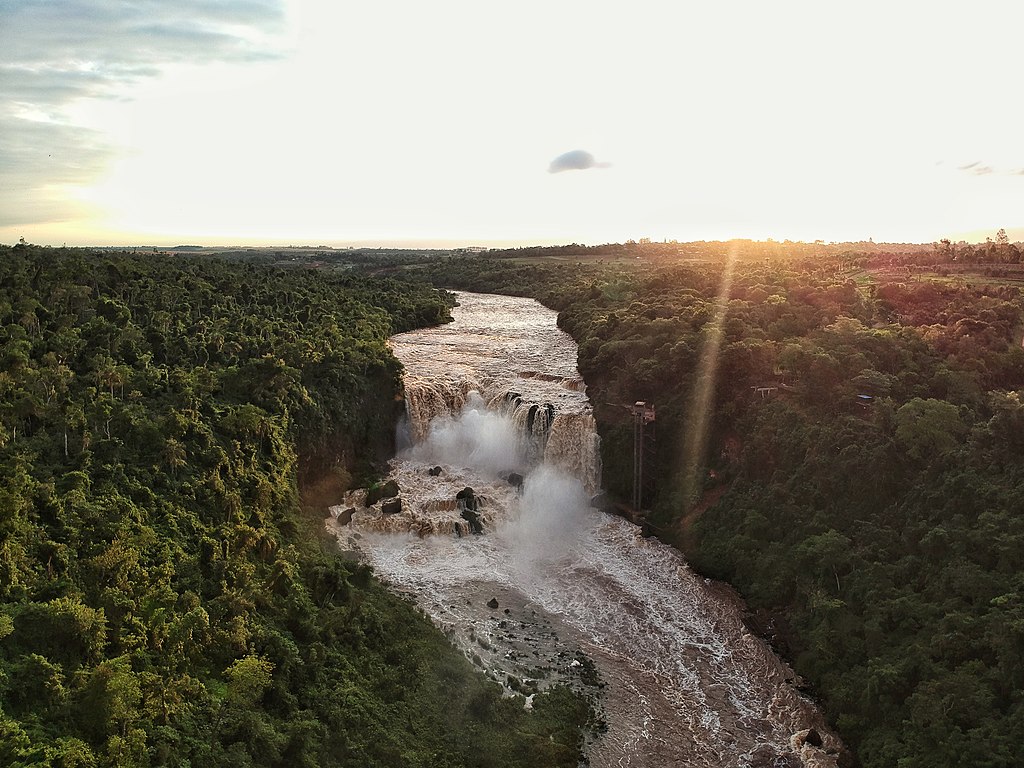
Key features of Saltos del Monday:
- Waterfalls: The main highlight of Saltos del Monday is its waterfalls, which flow over rocky cliffs and create a picturesque cascade. The falls are surrounded by dense vegetation, adding to the natural beauty of the area.
- Scenic Views: Visitors to Saltos del Monday can enjoy scenic views of the waterfalls and the surrounding landscape. The falls are particularly impressive during the rainy season when the water flow is at its peak.
- Trails: The park has well-maintained trails that allow visitors to explore the area, providing different vantage points to view the waterfalls. The trails often lead through the lush tropical vegetation, making it a pleasant hiking experience.
- Picnic Areas: There are designated picnic areas where visitors can relax, enjoy the scenery, and have a picnic amidst nature.
- Wildlife: The park is home to various wildlife species, and birdwatching is a popular activity. You may have the opportunity to spot colorful birds and other animals as you explore the area.
- Accessibility: Saltos del Monday is easily accessible from Ciudad del Este, making it a convenient day trip for both locals and tourists.
Ciudad del Este (Paraguay)
Ciudad del Este is a city located in eastern Paraguay, near the borders with Brazil and Argentina. It’s one of Paraguay’s largest and most important commercial centers, known for its vibrant shopping scene, bustling markets, and strategic location for international trade. Here are some key aspects of Ciudad del Este:

- Trade Hub: Ciudad del Este is renowned as a major commercial hub in the region. It’s a center for cross-border trade, attracting shoppers and traders from Brazil, Argentina, and other neighboring countries. The city’s location on the Paraná River, close to the Itaipu Dam (one of the world’s largest hydroelectric plants), has contributed to its economic significance.
- Shopping: The city is famous for its shopping opportunities, particularly for electronics, textiles, cosmetics, and a wide range of imported goods. Tourists often visit Ciudad del Este to take advantage of the competitive prices, and the city has numerous markets and shopping malls catering to different preferences.
- Imported Goods: The city is known for its vast array of imported products, often available at prices lower than those in surrounding countries. This has made it a popular destination for purchasing items ranging from electronics to clothing to household goods.
- Tourism: While Ciudad del Este is primarily known as a commercial city, it also serves as a gateway to explore the natural beauty of eastern Paraguay, including nearby waterfalls, such as Saltos del Monday, and the Itaipu Dam, which offers guided tours.
- Cultural Diversity: The city’s population is diverse, with a mix of Paraguayans, Brazilians, and other nationalities, contributing to a rich cultural tapestry. This diversity is reflected in the city’s food, languages, and customs.
- Safety: As with any busy urban area, visitors should exercise caution and be aware of their surroundings, especially in crowded markets. It’s important to take standard safety precautions and keep an eye on your belongings.
- Currency: The Paraguayan Guarani (PYG) is the local currency. While some places may accept U.S. dollars or Brazilian reais, it’s advisable to have some local currency for smaller purchases.
Bird Park (Brazil)
The Bird Park (Parque das Aves) is a popular avian conservation and tourist attraction located near the famous Iguazu Falls in Foz do Iguaçu, Brazil. This park is dedicated to the protection and preservation of a wide variety of bird species, many of which are native to the region. It offers visitors a unique opportunity to observe and learn about these beautiful birds in a naturalistic and educational environment. Here’s what you can expect at the Bird Park:
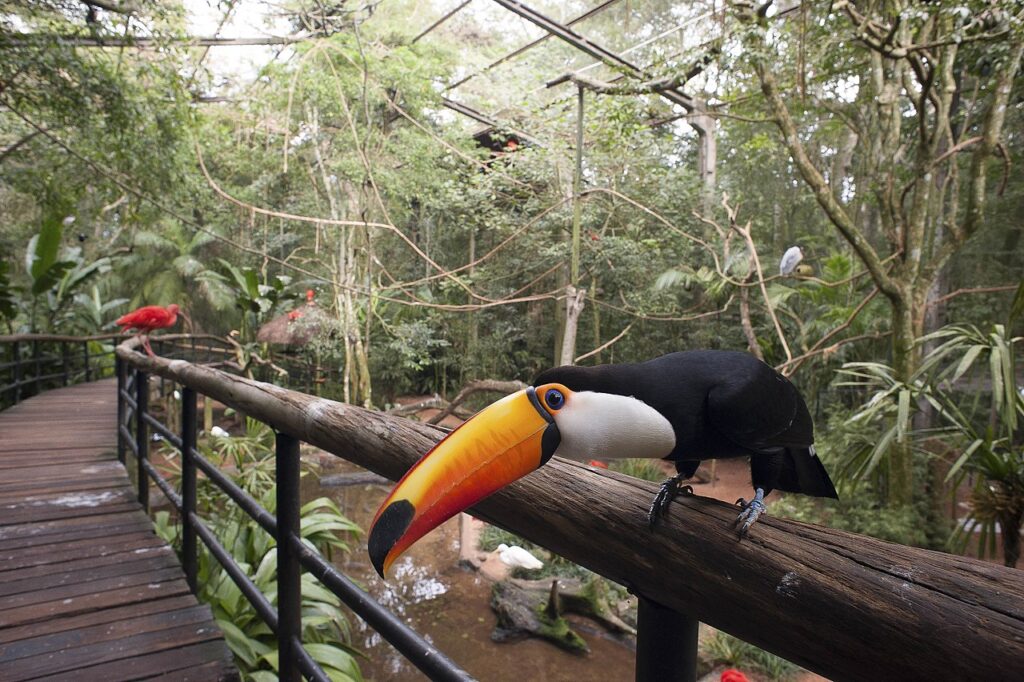
- Diverse Bird Species: The park is home to a vast collection of bird species from different parts of Brazil and other regions of the world. Visitors can see parrots, toucans, eagles, macaws, flamingos, and many other colorful and fascinating birds up close.
- Conservation: The Bird Park plays a crucial role in conservation efforts, including breeding and rehabilitation programs for endangered species. By visiting the park, you contribute to these conservation efforts, as the funds generated help support the care of the birds and their habitats.
- Educational Exhibits: The park provides informative exhibits that focus on the ecology, behavior, and conservation of birds. These exhibits offer insights into the importance of protecting these creatures and their ecosystems.
- Natural Habitats: The Bird Park aims to create naturalistic environments for the birds, allowing them to live in conditions as close to their natural habitats as possible. This makes for a more authentic and respectful experience for both the birds and the visitors.
- Photography Opportunities: The park’s layout and well-designed enclosures offer excellent opportunities for photography. Capturing the vibrant colors and unique features of the birds is a favorite activity for many visitors.
- Butterflies and Orchids: In addition to the birds, the Bird Park features butterfly and orchid exhibitions, adding to the overall experience of exploring the beauty of the Brazilian rainforest.
- Location: The Bird Park is conveniently located near the entrance to the Iguazu Falls National Park, making it a great addition to your visit to the falls. It’s an opportunity to learn more about the local wildlife and ecosystems.
Itaipu Dam (Brazil/Paraguay)
Visiting the Itaipu Dam is a fascinating experience that allows you to learn about one of the world’s largest hydroelectric projects, its impact on the region, and the generation of clean energy. Below, I’ll provide a general overview of what you can expect when visiting the Itaipu Dam:
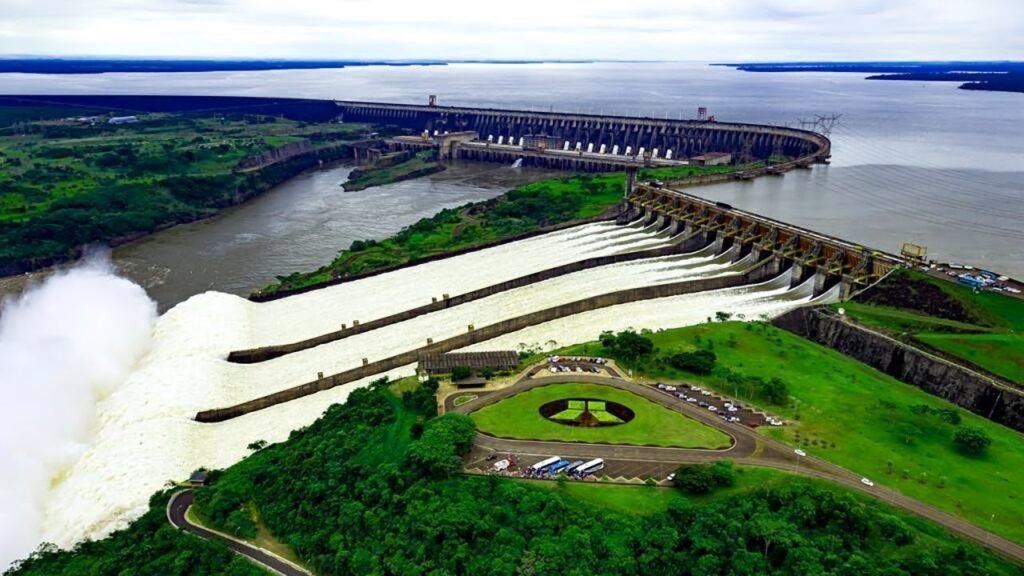
- Guided Tours: The most common way to visit the Itaipu Dam is by taking a guided tour. The tour guides provide valuable information about the dam’s history, engineering, and significance for both Brazil and Paraguay. The tours are informative and designed to showcase the various aspects of the dam.
- Visitor Centers: The Itaipu Dam often has visitor centers or educational facilities where you can learn about the dam through interactive exhibits, displays, and videos. These centers offer insights into the technology behind hydroelectric power and the environmental aspects of the dam.
- Reservoir and Spillway: Depending on the tour, you may get to see the vast reservoir created by the dam and the spillway, where water is released when the reservoir reaches a certain level. These aspects provide a visual understanding of the dam’s scale.
- Dam Wall: Some tours allow visitors to get relatively close to the dam wall, providing an impressive view of the concrete structure. The dam’s size and engineering are awe-inspiring from this vantage point.
- Lighting Show: If you’re visiting in the evening, you might have the opportunity to witness the dam’s lighting show. The illuminated dam creates a captivating display, highlighting the enormity of the structure.
- Environmental Impact: Some tours may discuss the environmental impact of the dam on the local ecosystem and the efforts made to mitigate these effects.
- Cultural and Economic Aspects: The guides often share information about the cultural and economic significance of the Itaipu Dam for the surrounding region.
- Booking Information: It’s essential to check in advance for tour availability, schedule, language options, and any visitor requirements. You can usually book tours through the official website or visitor centers.
Remember that tour offerings may change over time, and it’s essential to verify the details before planning your visit. Additionally, be respectful of any rules or guidelines provided by the tour operators to ensure a safe and informative experience.
San Ignacio Mini (Argentina)
San Ignacio Mini is an archaeological site and a former Jesuit Reduction (a type of settlement established by Jesuit missionaries) located in the Misiones province of Argentina. It’s part of the Jesuit Missions of the Guaranis, a UNESCO World Heritage site that includes several other missions in the region. San Ignacio Mini is one of the most well-preserved and accessible of these missions, offering valuable insights into the history and culture of the Jesuit presence in South America during the colonial period. Here are some key points about San Ignacio Mini:
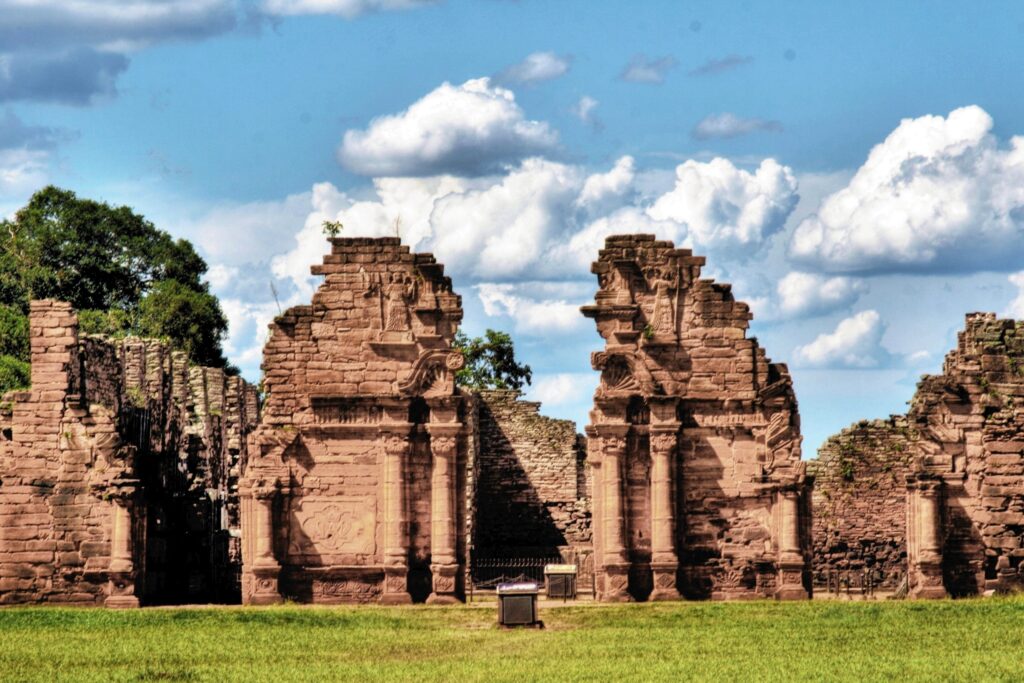
- Jesuit Mission: San Ignacio Mini was one of the many Jesuit Reductions founded in the 17th century with the aim of converting and educating the local Guaraní indigenous population. These missions were self-sufficient communities with churches, houses, workshops, and agricultural areas.
- Architectural Beauty: The main attraction at San Ignacio Mini is the architectural complex, which includes the ruins of the mission’s church, residential buildings, and other structures. The buildings showcase a unique blend of European and indigenous architectural styles.
- Cultural Significance: The mission is a testament to the cultural interchange that occurred between the Jesuits and the indigenous Guarani people. The missions became centers of education, art, music, and religious practice, leading to the development of a distinctive Guaraní Baroque style.
- Guided Tours: Visitors to San Ignacio Mini can explore the site through guided tours. Knowledgeable guides often provide historical context, explain the layout of the mission, and share stories about the lives of the Guarani and the Jesuit missionaries.
- Visitor Center: Many archaeological sites have visitor centers with exhibits, displays, and information about the history, culture, and significance of the mission. These centers enhance the educational experience for visitors.
- Cultural Events: Occasionally, San Ignacio Mini hosts cultural events, such as traditional music and dance performances, providing a glimpse into the rich cultural heritage of the region.
- UNESCO World Heritage: The Jesuit Missions of the Guaranis, including San Ignacio Mini, were designated as a UNESCO World Heritage site in 1983, recognizing their historical and cultural importance.
Visiting San Ignacio Mini allows you to step back in time and appreciate the efforts of the Jesuit missionaries in creating these vibrant communities. It’s a significant historical and cultural destination in Argentina, offering a unique opportunity to learn about the colonial period and the interactions between different cultures in South America.
Three Borders Landmark (Brazil)
The Three Borders Landmark (Marco das Três Fronteiras) is a “three in one” tourist spot, which allows the visitor to contemplate the border landscape of Brazil, Argentina and Paraguay.
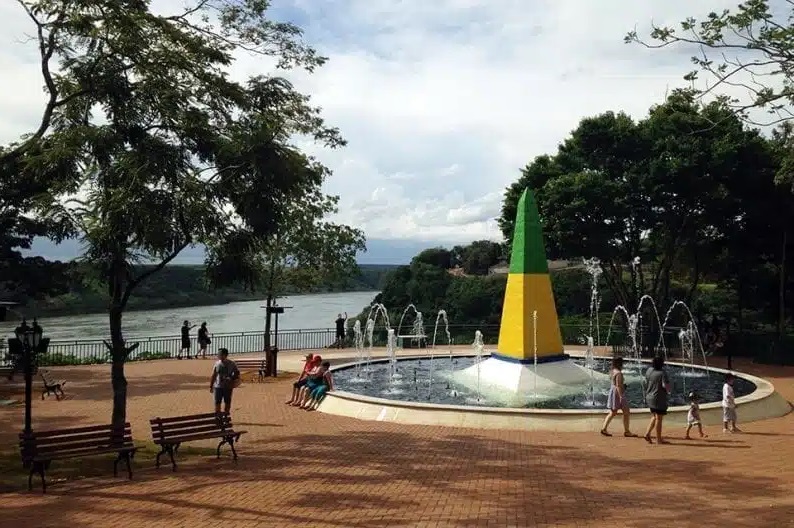
Inaugurated in 1903, the attraction underwent a recent revitalization. The obelisk set in place more than 100 years ago now has a water mirror and lights. The Jesuit Missions Scenographic Village recalls the history of the priests and indigenous people who inhabited the region in the 16th and 17th centuries. The Cabeza de Vaca Memorial tells the saga of the first white man to see the Iguaçu Falls, in 1542. The public can contemplate the beautiful sunset with a view of the Iguaçu and Paraná rivers, enjoy the cultural show and enjoy the delicacies of gastronomy regional.
Three Borders Milestone (Argentina)
As its own name indicates, the Three Borders Milestone (Hito Tres Fronteras) is a strategic viewpoint spot in Argentina form where you can see 3 borders: Argentina, Paraguay and Brazil. The cities of Puerto Iguazú, Ciudad del Este and Foz do Iguaçu respectispotvely since 3 countries and 2 rivers (Iguazú River and Paraná River) meet at that exact spot.
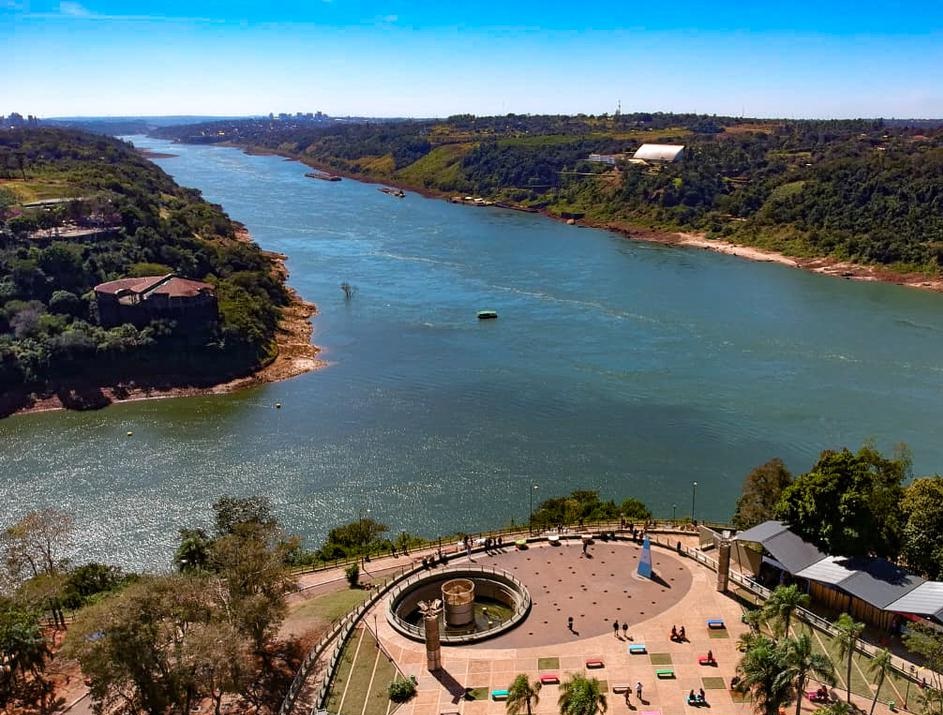
In the surroundings, there is an artisan fair where you can buy handicrafts and regional products such as yerba mate, t-shirts, and leather backpacks, among others. It is a perfect place to find a souvenir or gift. There is also a cafeteria, rest areas, hammocks, and a playground for children.
Conclusions: Iguazu Falls, What to see
In conclusion, traveling to Iguazu Falls is a remarkable adventure that offers a blend of natural beauty, cultural experiences, and thrilling activities. It’s a destination that should be on the bucket list of any nature lover or traveler seeking a memorable and awe-inspiring journey.
You might also be interested in:
- Belmond das Cataratas Hotel, comfort inside Iguazu Falls National Park
- Iguazu Falls best pictures, HD photos & images you have never seen
- Iguazu Falls Private Transfers and Tour

